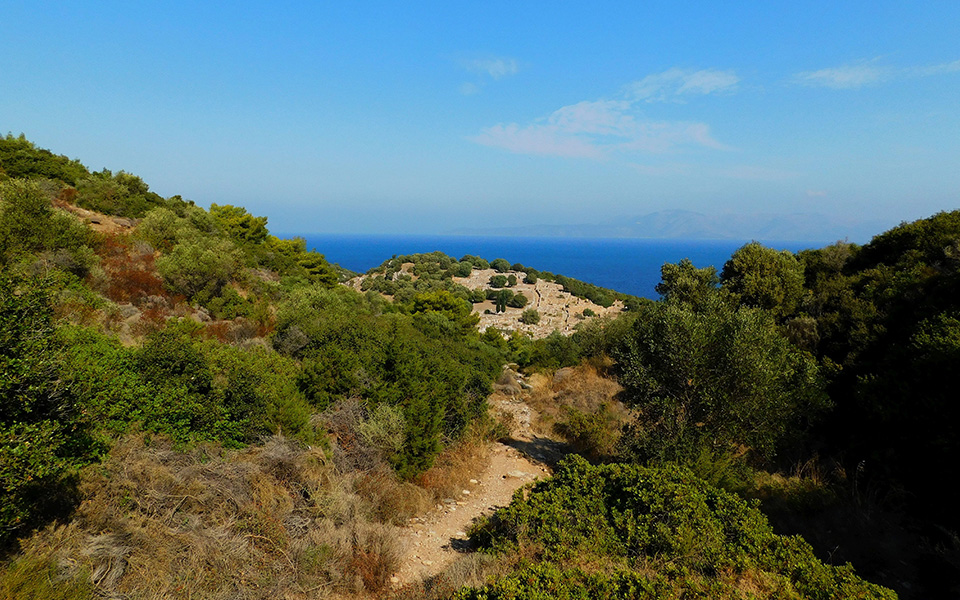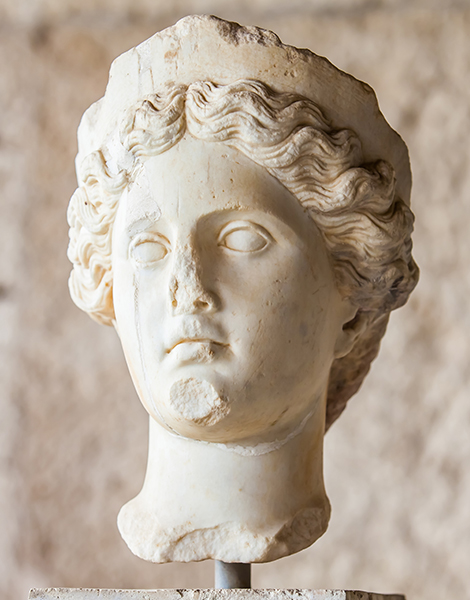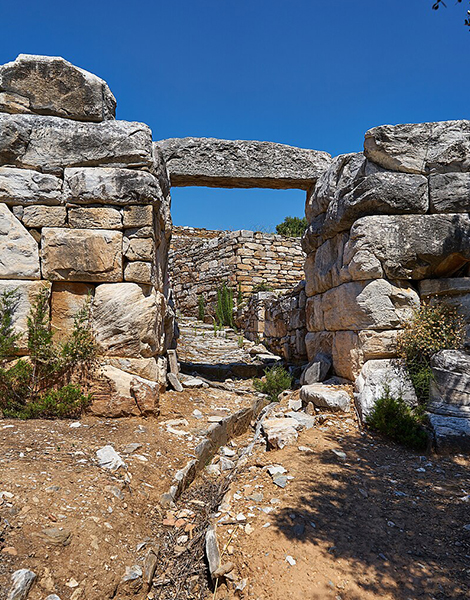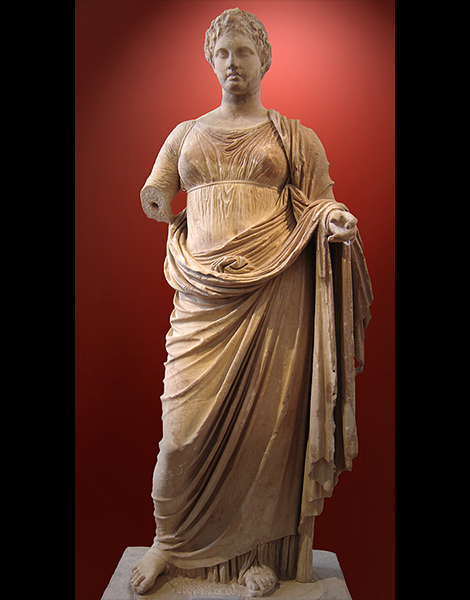Nestled on the rugged northeast coast of Attica, the ancient city of Rhamnous is a remarkable yet lesser-known archaeological treasure. Located approximately 55km northeast from Athens, just north of Agia Marina and a short distance from the famous burial mounds at Marathon, this historic site commands stunning views across the Gulf to the island of Evia. Though overshadowed by Attica’s more famous landmarks, Rhamnous remains one of the largest and best-preserved ancient “deme” (local municipality) sites in the region, combining history, natural beauty, and a serene atmosphere.
In antiquity, Rhamnous was celebrated for its sanctuary of Nemesis, the chthonic goddess of retribution and divine vengeance. Revered as the most significant shrine dedicated to this implacable deity in the ancient Greek world, the site gained prominence even before the fortified settlement rose to strategic importance in the 5th century BC. Positioned on a headland with two small harbors—now silted up—it played a vital role in safeguarding Athens’ supply lines during conflicts like the Peloponnesian War (431-404 BC). Today, its ruins provide a tranquil retreat, the perfect escape from the hustle and bustle of Athens, where the timeless beauty of Greece’s past mingles with unspoiled nature.
Whether you come for the history, the mythology, or simply the breathtaking scenery, Rhamnous promises an unforgettable outing —and perhaps the rare chance to explore it in solitude. Comfortable shoes and a sense of adventure are all you need to unlock its secrets.
Info
Tel. (+30) 22940.634.77, open daily except Tuesday, 08:30-15:15 (last visit to the ancient city is 14:00), Ticket €4.

© Shutterstock
The Road to Rhamnous
The journey to Rhamnous is as enchanting as the destination. A narrow road winds through olive groves and sunlit hills before reaching the edge of a forest, where a 1.5-kilometer footpath leads to the site. The area brims with wildlife and is blanketed by thick, prickly Buckthorn bushes (“ramnos”), which inspired the city’s name, interspersed with vibrant wildflowers. This serene landscape sets the stage for the ancient ruins that quietly emerge, their timeworn stones basking in the bright Attic sun.
Your first view of Rhamnous unveils its spiritual core: the sacred enclosure (“temenos”) of the Sanctuary of Nemesis, perched on an expansive artificial platform. Ancient traveler Pausanias (1.33.2) described Nemesis as the “most implacable deity to men of violence.” Known also as “Rhamnousia” or “the goddess of Rhamnous,” she was revered as a protector of cosmic order and a force against human arrogance and hubris.
A fascinating myth links Nemesis to the origins of the Trojan War. One version tells how, after an encounter with Zeus disguised as a swan, Nemesis laid an egg. This egg, said to contain Helen of Troy and the “Dioskouroi” (Gemini Twins, Castor and Polydeuces), was entrusted to Leda, the Spartan queen, to raise as her own. The story is vividly depicted on the base of a renowned statue of Nemesis from Rhamnous, where Leda presents Helen to the goddess.
An alternate Spartan version of the myth claims Leda laid two eggs herself—one containing Helen and Polydeuces, the other holding Castor and Clytemnestra. Both variations firmly connect Nemesis—and the site of Rhamnous—to one of the most celebrated tales in ancient Greek mythology.


© Shutterstock
Early Settlement and the Sanctuary’s Beginnings
Archaeological evidence indicates that Rhamnous was inhabited long before its classical structures were built, with traces of human activity dating back to the Neolithic era (“New Stone Age”). By the late Archaic period, around the end of the 6th century BC, the site had evolved into a place of worship, paving the way for its later prominence as the Sanctuary of Nemesis and her counterpart, Themis, goddess of justice. Early finds, such as Laconian roof tiles and poros stone fragments, suggest the presence of an initial temple, likely destroyed during the First Persian Invasion of Greece in 490 BC, immediately prior to the Battle of Marathon.
In the decades that followed, the sanctuary underwent a significant transformation, becoming a hub of spiritual devotion. Its strategic location, near the plains of Marathon and close to accessible harbors, made it a natural center for worship. Two notable temples were constructed during this period. Rhamnous was part of the Attic deme associated with the “Aiantis” tribe, named after Ajax the Great, a legendary hero of the Trojan War
Constructed in the early 5th century BC, the smaller temple, dedicated to both Nemesis and Themis, showcased the polygonal masonry style typical of the island of Lesbos. Measuring about 10 by 6 meters, the temple originally housed a human-sized cult statue, fragments of which are now on display in the British Museum. A statue of Themis, dated to 300 BC, and several other dedications, unearthed in the cella, can be seen at the National Archaeological Museum, Athens. Over time, this temple may have functioned as a treasury or repository for statues and offerings, underscoring its enduring significance.

© Shutterstock
Spiritual Heart
Later in the century, a more imposing temple was constructed in the Doric peripteral style, nearly twice the size of its predecessor. Measuring 22 meters long and 10 meters wide, it featured a colonnade of 6 by 12 columns encircling the central chamber, or cella. This grand structure likely dates to the Periclean era—the “Golden Age of Athens” in the mid- to late-5th century BC—when monumental architecture flourished throughout Attica. Its design shares similarities with the temples of Poseidon at Sounion and Hephaestus in Athens, leading to speculation that all three may have been designed by Kallikrates, the architect of the Parthenon. However, construction on the Temple of Nemesis was not completed until around 420 BC, likely delayed by the outbreak of the Peloponnesian War in 431 BC.
The temple housed a renowned cult statue of Nemesis, described as “10 cubits in height” and often attributed to Pheidias, the master sculptor behind the Parthenon’s iconic sculptures. Some, however, credit the 4m-high statue to Agorakritos of Paros, a pupil of Pheidias. Writing in the 2nd century AD, the traveler Pausanias noted that the statue was crafted from a single block of Parian marble originally brought by the Persians to create a victory monument—an ironic twist after their defeat at Marathon.
Pausanias reflected on the irony of the marble’s origins:
“It is thought that the wrath of this goddess fell also upon the foreigners who landed at Marathon. For thinking in their pride that nothing stood in the way of their taking Athens, they were bringing a piece of Parian marble to make a trophy, convinced that their task was already finished.” (Pausanias, 1.33.2)
Despite suffering enemy raids and significant damage, the temple remained a revered site for centuries until its destruction in the late 4th century AD. During Roman rule, it was rededicated to the deified empress Livia, wife of Augustus, and her grandson, emperor Claudius, in the mid-1st century AD—a testament to its lasting significance.


The Fortified City
A trail from the sanctuary leads to the fortified acropolis of Rhamnous, a hilltop stronghold that once protected the coastline. Built during the late 5th century BC, amid the Peloponnesian War, its formidable walls and gates reflect Rhamnous’ dual role as both a religious hub and a military outpost. Like the fortress at Sounion, it served as a vital defensive position, safeguarding Attica’s northeastern coast and overseeing the straits to the island of Evia.
Perched on a 28-meter-high hill, the acropolis spans approximately 230 by 270 meters. Its imposing marble walls, quarried from nearby Agia Marina, still stand today, with the southern gate towering at an impressive 6.1 meters. Inside the walls, visitors can discover a gymnasium, a small theater—likely used for local assemblies and cultural events—a sanctuary of Dionysus, and various public buildings and homes. This well-organized garrison town once housed young Athenian soldiers, or “ephebes,” completing their two-year military training, alongside a vibrant local community.
Beyond the acropolis, restored burial monuments line the ancient road that once connected Rhamnous to Marathon, offering a glimpse into the region’s funerary traditions.

Archaeological Discovery and Preservation
Rhamnous remained largely undisturbed until the late 19th century, when initial excavations began. In 1817, the Society of Dilettanti—a group of British noblemen and scholars—produced the first detailed plans of the temples. Later excavations in the late 19th century, led by Greek archaeologists D. Philias and V. Stais, uncovered many of the site’s treasures. However, consistent archaeological work only took shape in the latter half of the 20th century.
Today, ongoing efforts by the Archaeological Society at Athens, in close collaboration with the Hellenic Ministry of Culture, continue to illuminate the significance of Rhamnous. From its earliest sacred structures to its strategic role during Greece’s turbulent classical period, the site remains a powerful testament to the enduring legacy of ancient Greek architecture, religion, and military ingenuity.

© Olga Charami
Tips for Visiting Rhamnous
Getting There: Rhamnous is a 90-minute drive from Athens. The final approach includes a 1.5-kilometer walk through scenic countryside.
What to Bring: Be sure to pack comfortable shoes, plenty of water, and a hat, especially during the summer months.
Nearby Attractions: Combine your visit with a trip to Marathon or the Amphiarieon of Oropos for a full day of exploration.












